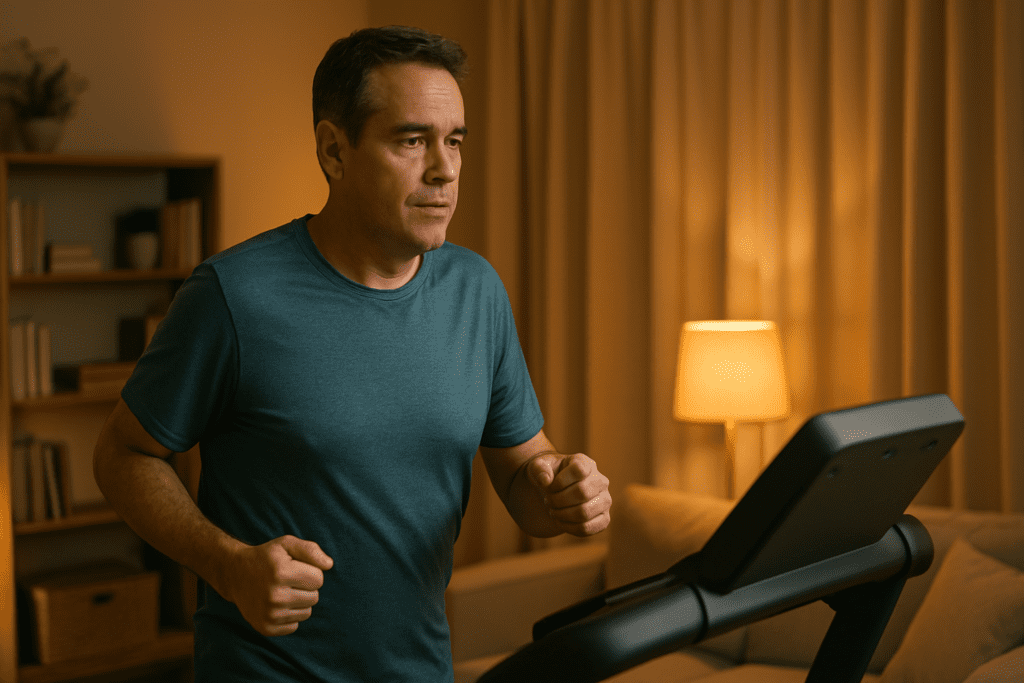Maintaining a healthy body weight is not solely about watching what’s on your plate. While nutrition plays a vital role, physical activity is the second pillar of weight management, particularly for long-term stability. Yet, many adults face the challenge of understanding how much physical activity they actually need to maintain their current weight—especially when their daily routines only include 30 minutes or less of moderate movement. The question of how much physical activity do I need to maintain weight becomes especially relevant in a modern world dominated by sedentary habits, desk jobs, and digital convenience.
You may also like: Top Cardiologist-Approved Cardio Workouts to Improve Cardiovascular Fitness and Heart Health Naturally
For those who assume they are sufficiently active with 30 minutes or less of daily movement, there may be surprising insights ahead. Emerging research and clinical guidelines reveal that while even minimal activity confers heart and metabolic benefits, it may not be enough for effective weight maintenance—particularly in aging adults or those with metabolic risk factors. This article unpacks the science behind weight regulation, provides evidence-based guidance on energy balance, and offers tailored recommendations for adults who fall below the 30-minute activity threshold. Whether you’re managing your weight proactively or noticing a gradual increase despite a “normal” routine, this expert guide will clarify how much physical activity is truly needed to support a healthy weight and prevent weight-related cardiovascular disorders.
The Science of Energy Balance: Calories In Versus Calories Out
At the heart of weight maintenance lies a deceptively simple equation: energy intake must equal energy expenditure. However, the biology behind this equation is far more complex, influenced by age, muscle mass, hormone levels, stress, sleep, and activity type. While many people ask, how much physical activity do I need to maintain weight, the answer depends on how many calories they consume and how their bodies burn energy throughout the day.
Energy expenditure has three key components: basal metabolic rate (BMR), the thermic effect of food, and physical activity. BMR accounts for the largest portion—typically 60 to 70 percent of daily energy burn. The thermic effect of food adds about 10 percent, depending on macronutrient composition. The remaining 20 to 30 percent comes from physical activity, and this includes both intentional exercise and incidental movement such as walking, standing, or even fidgeting.
When daily activity falls below 30 minutes, total daily energy expenditure may not be sufficient to offset caloric intake, particularly in adults consuming the standard 2,000 to 2,500 calories. The result is often slow but steady weight gain over time, even in those who consider themselves “not overeating.” This underscores why understanding how much physical activity do I need to maintain weight, assuming you participate in 30 minutes or less physical activity, is so essential to avoiding gradual weight creep.
Why 30 Minutes May Not Be Enough for Weight Maintenance
The common benchmark of 30 minutes of moderate physical activity per day, often recommended by public health agencies, is generally aimed at improving cardiovascular health—not necessarily weight control. While 30 minutes can reduce blood pressure, improve insulin sensitivity, and support mental well-being, it may fall short when it comes to sustaining energy balance in adults with sedentary lifestyles, slow metabolisms, or high-calorie diets.
A growing body of evidence suggests that 45 to 60 minutes of moderate activity per day may be more effective for maintaining weight over time. In individuals who already struggle with weight gain or metabolic conditions, even more movement may be required. The National Weight Control Registry, which tracks people who successfully maintain significant weight loss, consistently finds that most participants engage in at least one hour of daily physical activity.
For adults wondering how much physical activity do I need to maintain weight if they only get 30 minutes or less, the answer may be discouraging at first. But it also presents an opportunity: even modest increases—such as adding 10 to 15 minutes of walking or stretching—can make a significant difference over time. Moreover, when done consistently, these small changes compound into meaningful metabolic improvements.

Hidden Contributors to Low Physical Activity in Adults
Many adults overestimate their daily activity levels due to the “activity illusion,” where brief bursts of movement or incidental tasks are mistaken for sufficient exercise. Taking the stairs once, walking to the mailbox, or doing house chores can create a false sense of accomplishment—especially when most of the day is spent seated. This overestimation leads individuals to believe they’re meeting recommended levels of activity, when in reality, they fall well short of the threshold required to maintain weight.
Additionally, digital lifestyles are exacerbating the issue. Remote work, screen-based entertainment, and online shopping mean fewer daily opportunities to move. Even regular gym-goers may find themselves sedentary for the remaining 23 hours of the day. This mismatch between perceived and actual activity is one of the reasons why people often ask, how much physical activity do I need to maintain weight, assuming you participate in 30 minutes or less physical activity?
Moreover, with age, the body naturally loses muscle mass—a phenomenon known as sarcopenia—which lowers resting metabolic rate. Adults in their 40s, 50s, and beyond may find that their previous activity levels no longer yield the same weight stability. Without adjustments in physical activity or diet, the body quietly shifts toward fat storage, particularly around the abdomen, increasing cardiovascular risk even in those who appear outwardly slim.
Cardiovascular Implications of Inadequate Physical Activity
Maintaining a stable weight is not just about aesthetics; it is tightly linked to cardiovascular health. Physical inactivity is a leading risk factor for heart disease, hypertension, and stroke. When activity drops below optimal levels, it affects lipid metabolism, blood pressure regulation, and endothelial function. Even in the absence of overt weight gain, inactivity can promote visceral fat accumulation, elevate LDL cholesterol, and increase arterial stiffness.
For individuals wondering how much physical activity do I need to maintain weight, the cardiovascular dimension is just as critical. Weight stability maintained through physical movement helps reduce inflammation, improve heart rate variability, and promote favorable blood glucose control. All of these factors are essential in preventing conditions such as metabolic syndrome, coronary artery disease, and atrial fibrillation.
Notably, adults who perform less than 30 minutes of physical activity per day often fall into the low-fitness category, which is associated with significantly higher mortality risk—even when controlling for BMI. The protective effect of physical activity extends far beyond calorie burn; it improves the heart’s efficiency, lowers resting heart rate, and enhances vascular elasticity. Therefore, increasing physical activity is not only important for weight—it’s an investment in long-term cardiovascular resilience.
Rethinking Physical Activity Beyond the Gym
When evaluating how much physical activity do I need to maintain weight, it is vital to broaden our definition of movement. Traditional exercise—jogging, cycling, strength training—is just one piece of the puzzle. Non-exercise activity thermogenesis (NEAT), which includes activities like walking to the store, gardening, taking the stairs, or playing with children, also contributes meaningfully to total daily energy expenditure.
NEAT is especially important for individuals who engage in 30 minutes or less of formal exercise each day. Simple lifestyle modifications—such as walking while on phone calls, parking farther away from store entrances, or using a standing desk—can increase energy expenditure by 200 to 400 calories per day. Over weeks and months, these seemingly insignificant choices can tilt the energy balance in favor of weight maintenance.
Moreover, NEAT tends to decline as individuals age or become more efficient in their routines. It requires conscious effort to maintain an active lifestyle when technology and convenience minimize physical exertion. For those seeking answers about how much physical activity do I need to maintain weight, integrating NEAT into daily routines may be the most sustainable and least intimidating starting point.
Strategies to Increase Physical Activity for Weight Maintenance
For adults engaging in 30 minutes or less of daily physical activity, the path to sustainable weight maintenance begins with small, intentional changes. These changes should be gradual, enjoyable, and adaptable to personal lifestyle. The first step is often a mindset shift—recognizing that physical activity does not need to be intense or time-consuming to be effective.
One of the most evidence-backed strategies is to aim for activity accumulation. Rather than scheduling a single 45-minute workout, individuals can aim for three 15-minute walks throughout the day—morning, lunchtime, and evening. This approach fits more naturally into most schedules and provides metabolic boosts after meals. In fact, post-meal walking has been shown to significantly reduce blood sugar spikes and improve insulin sensitivity.
Resistance training is another often overlooked tool in the weight maintenance toolbox. While many associate physical activity solely with aerobic exercise, adding two to three sessions of bodyweight or resistance band workouts per week can preserve lean muscle mass and increase metabolic rate. This is especially important for individuals over 40, whose muscle mass tends to decline without intervention.
Importantly, behavior change strategies—such as habit stacking, social accountability, and tracking tools—can improve adherence. For instance, linking movement to an existing habit (e.g., doing squats after brushing teeth) or using a pedometer to aim for incremental increases in step count can reinforce daily consistency. As more adults ask how much physical activity do I need to maintain weight, assuming you participate in 30 minutes or less physical activity, these scalable solutions provide practical answers grounded in behavior science and physiology.
How Diet Interacts with Physical Activity for Weight Control
Physical activity is only one half of the weight maintenance equation. When activity levels are low, dietary choices carry even more weight. Consuming a high-calorie diet while engaging in minimal movement creates a surplus that the body stores as fat. This is why individuals who ask how much physical activity do I need to maintain weight must also consider their caloric intake and nutrient quality.
One effective approach is energy budgeting. If you’re only expending a modest number of calories through activity, your diet must reflect this lower energy requirement. High-protein meals, fiber-rich vegetables, and healthy fats can support satiety while limiting caloric excess. Reducing intake of processed foods, sugary beverages, and large portion sizes becomes especially important when movement is minimal.
Moreover, meal timing can also influence weight regulation. Intermittent fasting, time-restricted eating, or avoiding late-night meals have shown promise in some studies for improving metabolic efficiency. However, these strategies should always be personalized and discussed with a healthcare provider—especially in individuals with cardiovascular concerns or diabetes risk.
When evaluating how much physical activity do I need to maintain weight, assuming you participate in 30 minutes or less physical activity, it becomes clear that nutrition and movement must work together in harmony. While you can’t out-exercise a poor diet, neither can you rely on food restriction alone for sustainable results. The interplay of both elements is where real success lies.

Personalized Approaches and Medical Considerations
Not all bodies respond the same way to physical activity, and individualized considerations are essential. Genetic factors, medication side effects, hormonal changes, and underlying health conditions all affect how efficiently the body burns calories and stores fat. For example, thyroid disorders, insulin resistance, or beta-blockers for high blood pressure may reduce exercise tolerance or metabolic rate.
Older adults may also face mobility limitations or chronic pain, making traditional forms of exercise challenging. In such cases, water aerobics, chair yoga, or physical therapy-led programs can help maintain functional movement without joint strain. For these individuals, asking how much physical activity do I need to maintain weight requires a nuanced, medically informed answer that considers safety, accessibility, and adaptability.
Working with a healthcare provider, registered dietitian, or exercise physiologist can ensure that recommendations are personalized and evidence-based. Assessments such as body composition analysis, VO2 max testing, and resting metabolic rate measurements can further refine the picture. These insights allow for realistic goal setting and remove the guesswork from what otherwise feels like an ambiguous question.
Frequently Asked Questions: How Much Physical Activity Do I Need to Maintain Weight?
1. Can weight be maintained long-term with less than 30 minutes of daily physical activity?
While it’s possible for some individuals to maintain weight with less than 30 minutes of physical activity daily, this outcome typically relies on strict dietary regulation and favorable genetics. For most adults, weight maintenance becomes more challenging over time without consistent movement. If you’re asking, how much physical activity do I need to maintain weight, especially assuming you participate in 30 minutes or less physical activity, it’s important to know that long-term success under such limitations requires additional strategies. These might include muscle-preserving diets, tight caloric tracking, and stress management to prevent metabolic slowdown. Furthermore, hormonal shifts with aging and sedentary lifestyles often demand more than minimal movement to avoid weight gain.
2. Are there psychological or behavioral effects of low daily physical activity that impact weight maintenance?
Absolutely. Low physical activity levels can indirectly affect weight maintenance by influencing mood, sleep quality, and appetite regulation. People often underestimate the psychological benefits of even brief bouts of movement, which include reductions in cortisol, better serotonin balance, and enhanced motivation for healthy choices. When evaluating how much physical activity do I need to maintain weight, it’s worth considering how less than 30 minutes of activity can make emotional eating, cravings, and poor sleep more likely. These behavioral triggers, when unaddressed, can quietly undermine weight stability. Regular movement—even in small doses—acts as a behavioral anchor that helps regulate many habits that support long-term weight control.
3. How does physical activity below 30 minutes a day affect lean muscle mass and metabolic rate?
Engaging in minimal physical activity can lead to progressive muscle loss, especially after the age of 35, when muscle mass naturally begins to decline. Lean muscle is a primary driver of resting metabolic rate, meaning that without sufficient stimulation, the body’s daily caloric needs shrink. If you’ve ever wondered how much physical activity do I need to maintain weight, assuming you participate in 30 minutes or less physical activity, it’s crucial to factor in this loss of muscle efficiency. Without resistance-based movement or activity that challenges the muscles, fat gain becomes more likely, even if diet remains unchanged. Incorporating resistance training—even 10-minute bodyweight sessions—can help counteract this decline and preserve metabolic health.
4. Are there certain times of day when physical activity is more effective for weight control?
Emerging research suggests that the timing of physical activity may influence weight maintenance, particularly in relation to metabolism and glucose control. Morning workouts may improve fat oxidation and regulate appetite hormones, while post-meal movement—especially after dinner—has been shown to blunt blood sugar spikes. For those doing less than 30 minutes daily, asking how much physical activity do I need to maintain weight becomes even more strategic when considering when to move. A 10-minute walk after each meal, for example, may yield greater metabolic benefits than a single block of exercise in the evening. This time-distributed approach supports both energy balance and insulin sensitivity throughout the day.
5. How does sleep interact with physical activity and weight maintenance?
Poor sleep duration and quality have been repeatedly linked to weight gain, and low physical activity contributes to sleep disturbances. Individuals who sleep fewer than seven hours a night often experience higher ghrelin (hunger hormone) and lower leptin (satiety hormone) levels, which can lead to overeating. Interestingly, when you ask how much physical activity do I need to maintain weight, assuming you participate in 30 minutes or less physical activity, the answer becomes more complex in the context of poor sleep. Lack of movement can intensify insomnia or fragmented sleep, creating a feedback loop that worsens weight management. Adding just 10 minutes of light activity daily has been associated with improvements in both sleep quality and daytime energy levels.
6. Can wearable devices or fitness trackers help people stay accountable when doing less than 30 minutes of activity?
Fitness trackers are particularly effective for individuals who engage in minimal structured exercise but want to build more awareness around movement. While they don’t directly answer the question of how much physical activity do I need to maintain weight, they help illuminate how active (or inactive) a person truly is. Many underestimate their sedentary time, and real-time feedback can prompt healthy adjustments, like standing more frequently, stretching, or taking brief walks. Most devices also encourage micro-movement goals, such as hourly step counts or reminders to move, which help close the gap between inactivity and optimal physical engagement. For adults with 30 minutes or less of activity per day, trackers can transform passive awareness into active change.
7. Is high-intensity interval training (HIIT) a suitable method for adults who don’t have much time to exercise?
HIIT is a highly efficient training method that can benefit those short on time—especially adults trying to maintain weight despite limited physical activity. Research shows that even 7–15 minutes of well-structured HIIT can improve insulin sensitivity, aerobic capacity, and fat oxidation. If you’re evaluating how much physical activity do I need to maintain weight, assuming you participate in 30 minutes or less physical activity, HIIT offers a strategic way to maximize results within minimal time. However, it must be approached cautiously by beginners or those with cardiovascular conditions. Supervised HIIT or modified versions—like interval walking or bodyweight circuits—may provide safer alternatives with similar metabolic benefits.
8. How do social environments influence weight maintenance when physical activity is limited?
Social surroundings play a critical, often underestimated role in shaping physical activity habits. Supportive relationships can foster accountability, shared movement routines, and motivation, whereas sedentary peer groups may normalize inactivity. When people ask how much physical activity do I need to maintain weight, their environment often determines whether they follow through on recommended changes. Participating in group walks, joining a virtual fitness challenge, or even scheduling standing meetings at work can inject more movement into low-activity lifestyles. When social cues reinforce motion, even those doing less than 30 minutes of daily activity find it easier to remain engaged and consistent.
9. What role do hormones play in weight control when physical activity is minimal?
Hormones such as insulin, cortisol, leptin, and ghrelin are intricately linked to weight regulation and are influenced by both physical activity and stress. With less than 30 minutes of daily movement, hormonal imbalances may arise that increase hunger, fat storage, and inflammation. This means the question how much physical activity do I need to maintain weight is also about supporting healthy hormone function. Without adequate movement, cortisol levels can remain elevated, encouraging abdominal fat deposition, especially under chronic stress. Restorative physical activity—like yoga or brisk walking—not only burns calories but helps modulate these hormonal fluctuations, making weight maintenance more achievable even in time-constrained lifestyles.
10. How can people stay motivated to move more if they have very little free time?
Lack of time is the most common barrier to physical activity, but habit design can help overcome this challenge. Micro-movements, such as walking during phone calls, doing calf raises while brushing teeth, or stretching during screen breaks, help build momentum. Instead of asking only how much physical activity do I need to maintain weight, consider also how can I infuse movement into my existing schedule without disruption? The answer lies in repetition and reinforcement. Movement rituals—no matter how brief—reinforce identity-based behavior, which has been shown to support sustainable lifestyle change. Over time, these actions stack, transforming passive routines into active ones, even when time is scarce.

Conclusion: Finding Your Balance—Maintaining Weight with Less Than 30 Minutes of Activity
When considering how much physical activity do I need to maintain weight, assuming you participate in 30 minutes or less physical activity, it’s clear that there’s no one-size-fits-all answer—but there are clear principles. While 30 minutes of daily activity may support basic cardiovascular health, it often falls short of what’s required for weight maintenance, especially in adults with sedentary jobs, high-calorie diets, or slowing metabolisms.
The key lies in awareness, consistency, and gradual improvement. Whether it’s incorporating more NEAT into your daily life, extending your activity by just 10 to 15 minutes, or adjusting your nutrition to match your energy output, sustainable changes are within reach. Personalized strategies grounded in science and supported by medical professionals offer the best path forward.
Ultimately, physical activity is not just a calorie-burning tool—it’s a cornerstone of metabolic health, cardiovascular protection, and quality of life. For adults doing 30 minutes or less of physical activity, recognizing the need for more movement is not a failure—it’s a starting point for transformation. And with the right knowledge, support, and commitment, weight maintenance becomes not only possible, but empowering.
daily exercise for weight control, physical activity and metabolism, sedentary lifestyle risks, calorie burn without gym, energy balance and weight, maintaining weight with walking, how to stay active at home, non-exercise physical activity, cardiovascular fitness tips, light exercise for health, weight maintenance over 40, movement and mental health, time-efficient workouts, low impact fitness ideas, metabolism and aging, smart exercise for busy adults, fitness for desk workers, how to prevent weight gain, sustainable weight loss habits, physical inactivity and heart health
Further Reading:
Physical activity guidelines for adults aged 19 to 64
Physical Activity and Your Weight and Health
Disclaimer
The information contained in this article is provided for general informational purposes only and is not intended to serve as medical, legal, or professional advice. While MedNewsPedia strives to present accurate, up-to-date, and reliable content, no warranty or guarantee, expressed or implied, is made regarding the completeness, accuracy, or adequacy of the information provided. Readers are strongly advised to seek the guidance of a qualified healthcare provider or other relevant professionals before acting on any information contained in this article. MedNewsPedia, its authors, editors, and contributors expressly disclaim any liability for any damages, losses, or consequences arising directly or indirectly from the use, interpretation, or reliance on any information presented herein. The views and opinions expressed in this article are those of the author(s) and do not necessarily reflect the official policies or positions of MedNewsPedia.


